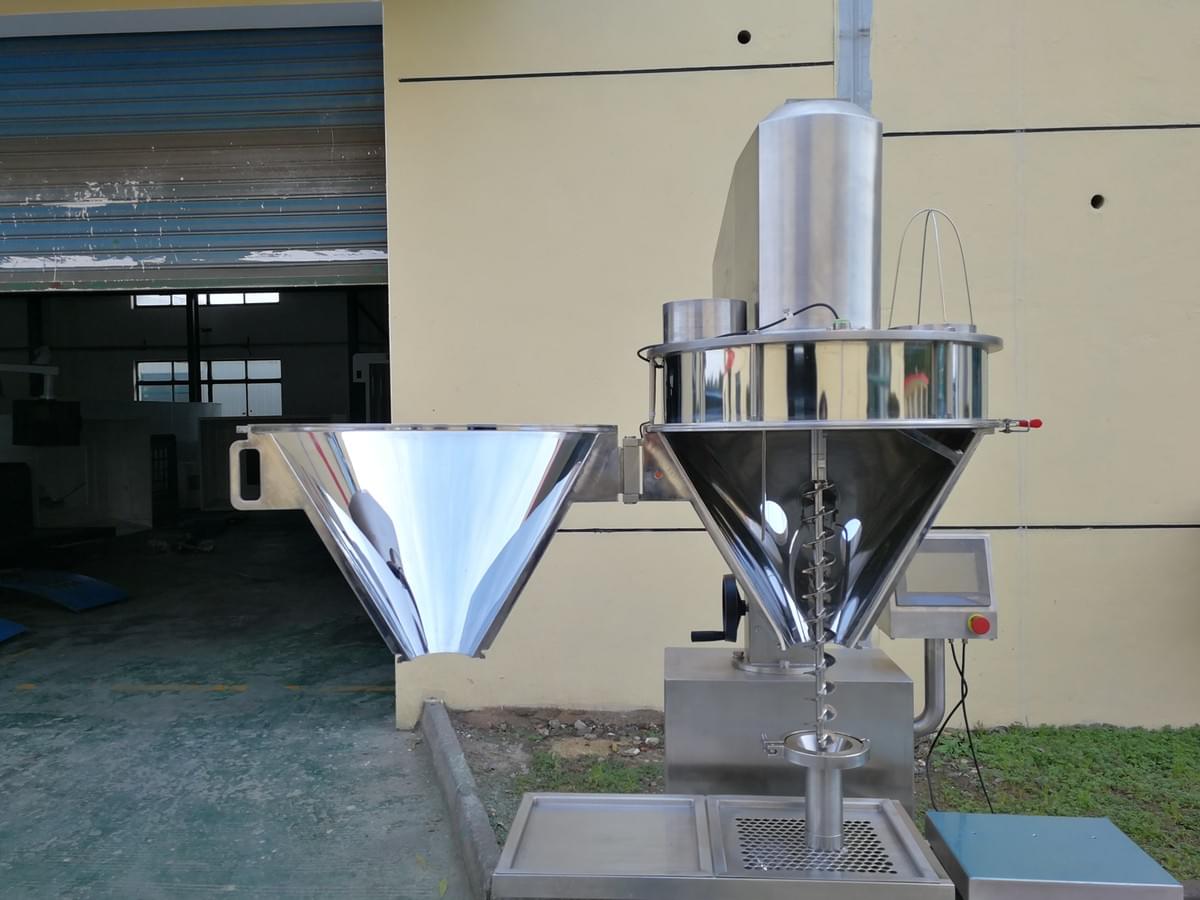Auger powder filling machines use a rotating screw (auger) to accurately fill powders into bottles, jars, or sachets. They are widely used in the pharmaceutical, food, and chemical industries for packaging products such as milk powder, protein powder, and antibiotics. While these machines are precise and versatile, problems may arise if maintenance or calibration is neglected.
Most issues with auger powder filling machines stem from three main factors: improper auger speed, powder caking, and weighing system calibration errors. Regular cleaning, stable auger speed, and controlled environmental conditions can prevent most of these problems.
The working principle of the auger system is simple: the rotating screw pushes powder through a hopper into the container or packaging bag. The accuracy depends on powder characteristics, auger dimensions, and motor speed. Understanding the interaction of these factors helps troubleshoot effectively and maintain efficiency.

Common Problems and Solutions
1. Uneven Filling Weight
Main Causes:
- Powder Bridging: Powder forms an arch at the hopper outlet, causing intermittent flow.
- Auger Issues: Unstable rotation speed or worn auger screw and sleeve can result in inaccurate volume per revolution.
- Powder Characteristics Variation: Differences in particle size, moisture content, or bulk density within the same batch lead to weight inconsistencies.
Solutions:
- Break the Bridge: Check powder flow in the hopper. If bridging occurs, clean the hopper immediately. Install anti-bridging devices, such as agitators or pneumatic pads, for powders prone to arching.
- Inspect and Replace: Examine auger screws and sleeves for wear. Replace both if wear exceeds allowable tolerance to ensure volumetric accuracy.
- Improve Flowability: Keep powder dry. Use dehumidifiers in the workshop if powders are hygroscopic.
- Precision Calibration: Recalibrate auger motor speed before each batch. Conduct multiple trial fills using a scale and adjust rotation or speed according to the difference between actual and target weight.
2. Powder Leakage Around the Nozzle
Main Causes:
- Mismatched Nozzle: Nozzle height or diameter does not fit container mouth properly.
- Timing Issues: Filling starts before the container is properly positioned.
- Worn Seals: Gaskets or O-rings at the filling head are worn or deformed.
Solutions:
- Precise Alignment: Adjust nozzle height and position to match the container neck tightly.
- Timing Adjustment: Program the PLC to synchronize filling action with container movement on the conveyor.
- Replace Seals: Regularly check, tighten, or replace gaskets and O-rings to prevent leaks.
3. Auger Overheating or Noise
Main Causes:
- Powder Build-Up: Hardened powder around the auger shaft or bearings increases friction, generating heat and noise.
- Foreign Objects: Debris from packaging material blocks the auger.
- Insufficient Lubrication or Damaged Bearings: Lack of maintenance or component failure.
Solutions:
- Immediate Cleaning: Stop the machine when abnormal noise or heat is detected. Disassemble and clean the auger thoroughly.
- Regular Maintenance: Lubricate bearings and transmission components as recommended in the equipment manual.
4. Static Electricity Accumulation
Main Causes: In dry environments, powder friction with metal surfaces generates static, causing powder to stick to hopper or auger walls, leading to inaccurate filling or cross-contamination.
Solutions:
- Active Neutralization: Install anti-static ionizers along the powder path to neutralize charges.
- Reliable Grounding: Ensure all metal components, including the hopper and auger, are properly grounded.
- Environmental Control: Maintain workshop relative humidity at 45–55% to minimize static buildup cost-effectively.
5. Sensor or Weighing Errors
Main Causes:
- Sensor Contamination: Powder accumulation or contact with external objects (wires, ducts) on the weighing sensor.
- Calibration Drift: Sensor accuracy can drift over time.
- Environmental Interference: Vibrations or strong airflow affect weight readings.
Solutions:
- Thorough Cleaning: Use a soft brush and dry cloth to clean the sensor and surrounding area. Ensure it is free from obstruction.
- Standard Calibration: Calibrate using standard weights at multiple points (zero, half, full scale).
- Eliminate Interference: Place the scale on a stable surface away from fans or air vents.
Best Practices and Preventive Maintenance
After each batch, clean the auger screw, hopper, and nozzle to prevent material buildup. Before each run, check auger alignment and rotation direction. Regularly replace gaskets and O-rings to avoid leakage. Conduct trial fills before production to confirm accuracy.
FAQs
1. How often should the auger system be calibrated?
Calibrate before each new batch or material change, as powder properties vary.
2. Why does the auger get blocked?
Sticky powders due to moisture or oil adhere to the screw and sleeve, eventually causing blockage. Keep powders dry and use Teflon-coated augers or hopper agitators for sticky powders.
3. Can the auger filler handle granular materials?
Yes, for small, free-flowing granules. Large particles may require volumetric fillers.
4. How to prevent powder segregation in the hopper?
Avoid excessive vibration, which separates fine and coarse particles.
Conclusion
Auger powder filling machines are highly precise but require careful calibration and cleaning. Most filling issues originate from inconsistent powder flow or auger speed. Regular cleaning, stable humidity, and proper calibration significantly extend machine life and improve output quality.
LTPM CHINA provides high-performance servo-driven auger fillers, along with:
- Up to 5 years warranty for peace of mind.
- Process tuning and optimization for your specific powder.
- Complete turnkey automation solutions from powder handling to finished packaging.
Contact us today for a customized quote and technical consultation!